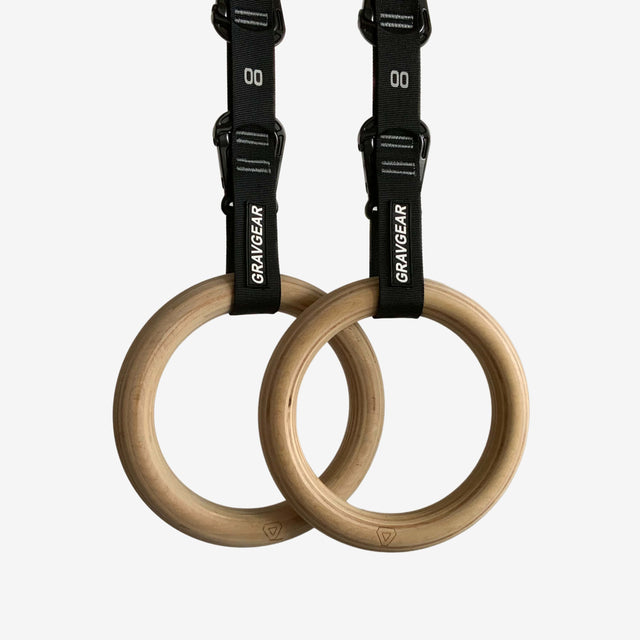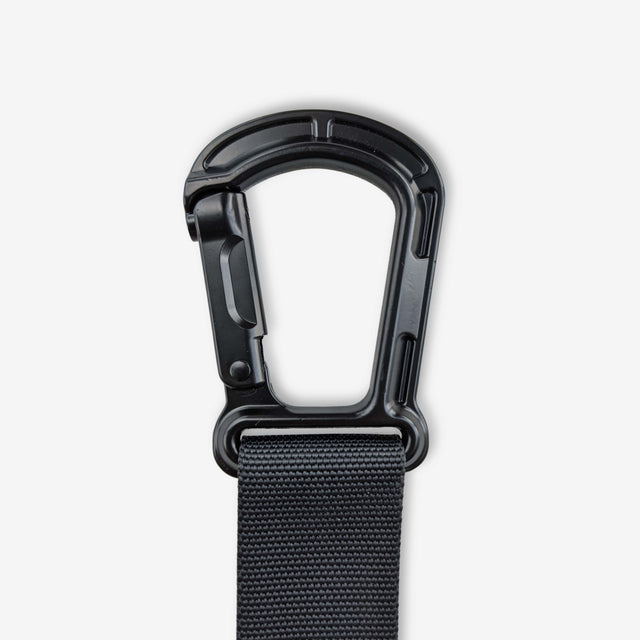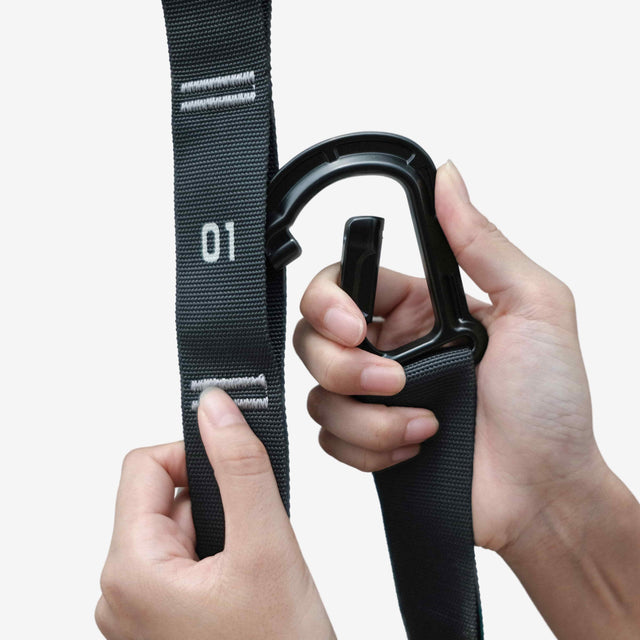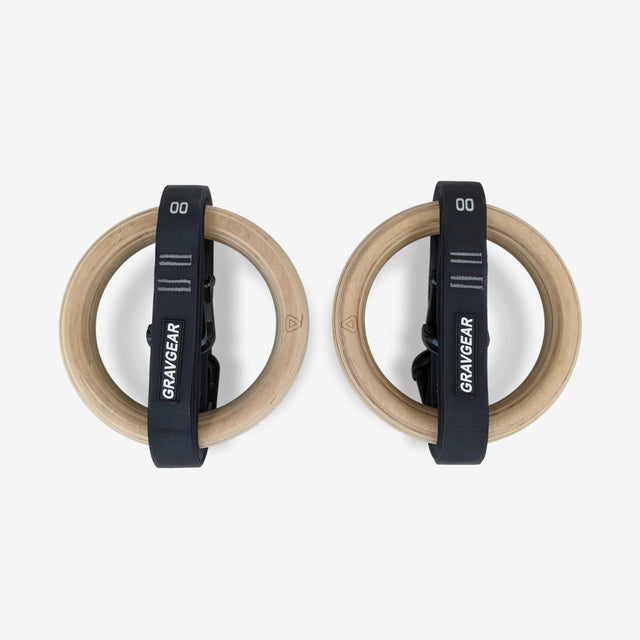17 Dundee-Approved Gymnastic Ring Exercises For Strength
If you’re looking to build real strength without the hassle of a full gym setup, gymnastic ring exercises might just be your new best mate. Gymnastics rings are easy to set up anywhere—from the backyard to the local park while the kids run around—and they’re perfect for beginners or anyone ready to push their limits. This guide covers the best gymnastic ring exercises for strength and mass, with everything from beginner gymnastic ring exercises to advanced moves like the iconic iron cross. So whether you’re after beginner-friendly holds, rows, or just the best gymnastics rings exercises to get you started, you’re in the right place.
We’ll cover:
- 1) Ring support hold
- 2) Ring rows / bodyweight rows
- 3) Assisted ring push-ups
- 4) Ring L-sit / tuck L-sit
- 5) Tuck hold / tucked knee hold
- 6) Ring dips / tricep dips
- 7) Ring pull-ups / neutral grip pull-ups
- 8) Ring archer rows / single-arm assisted rows
- 9) Ring archer push-ups / single-arm assisted push-ups
- 10) Inverted hang / upside-down hang
- 11) Ring bulgarian dips / wide ring dips
- 12) Tuck front lever / tuck lever hold
- 13) Ring muscle-up / pull-up to dip
- 14) Ring L-sit to shoulder stand / L-sit press to shoulder stand
- 15) Front lever / straight body lever
- 16) Back lever / reverse lever
- 17) Iron cross / T hold
1) Ring support hold
Foundational move targeting shoulders, arms, and core
| Level | Sets | Reps | Tempo | Rest |
| Beginner | 3 | 20s | Controlled hold | 60s |
| Intermediate | 3 | 35s | Controlled hold | 60s |
| Advanced | 4 | 50s | Controlled hold | 45s |
The ring support hold is a no-frills move for building core stability and shoulder strength.
It looks simple, but staying steady on the rings activates those small stabilizer muscles and sets you up for more advanced moves, like dips.
Form checklist:
✅ Core tight
✅ Shoulders down
✅ Hands steady
2) Ring rows / bodyweight rows
Builds back, biceps, and grip strength, ideal for upper body control
| Level | Sets | Reps | Tempo | Rest |
| Beginner | 3 | 6-8 | 4-1-2-0 | 60s |
| Intermediate | 4 | 8-10 | 4-1-2-0 | 60s |
| Advanced | 4 | 10-12 | 4-1-2-0 | 45s |
Ring rows are a top choice for building back, biceps, and grip strength.
Adjust your body angle to control difficulty—the closer you are to horizontal, the tougher the pull.
This move hits the upper body hard without straining your joints, and you’ll notice the improvement in your pulling power as you work up to bigger moves.
Form checklist:
✅ Core steady
✅ Shoulders down
✅ Full extension on each rep
3) Assisted ring push-ups
Builds chest, shoulders, and triceps strength, while engaging core stabilizers
| Level | Sets | Reps | Tempo | Rest |
| Beginner | 3 | 6-8 | 4-1-2-0 | 60s |
| Intermediate | 4 | 8-10 | 4-1-2-0 | 60s |
| Advanced | 4 | 10-12 | 4-1-2-0 | 45s |
Assisted ring push-ups are solid for building chest, shoulder, and tricep strength while firing up the core.
Adjust the ring height to find your level—higher makes it easier, lower adds intensity.
Focus on controlling the descent to get the most out of each rep, and you’ll build a strong foundation for standard ring push-ups down the line.
Form checklist:
✅ Core tight
✅ Elbows tucked
✅ Controlled descent
4) Ring L-sit / tuck L-sit
Must-have for core and upper body strength, targeting abs, shoulders, and hip flexors
| Level | Sets | Reps | Tempo | Rest |
| Beginner | 3 | 20s | Controlled hold | 60s |
| Intermediate | 4 | 35s | Controlled hold | 60s |
| Advanced | 4 | 50s | Controlled hold | 45s |
The ring L-sit and tuck L-sit are core staples for building strength and stability.
Start with the tuck L-Sit if you’re new to rings, then progress to the full L-Sit as you build balance and control.
Think of it as the “seat belt” that locks in your core for tougher moves down the line.
Form checklist:
✅ Core tight
✅ Shoulders down
✅ Legs straight
5) Tuck hold / tucked knee hold
Builds core stability and control, targeting abs and shoulders
| Level | Sets | Reps | Tempo | Rest |
| Beginner | 3 | 20s | Controlled hold | 60s |
| Intermediate | 4 | 35s | Controlled hold | 60s |
| Advanced | 4 | 50s | Controlled hold | 45s |
The tuck hold or tucked knee hold, is a go-to for core stability on the rings, keeping your abs and shoulders locked in.
Start with your knees tucked close to your chest for better balance, then work up to longer holds as your control improves.
Master this, and you’re set for tougher holds down the line.
Form checklist:
✅ Core tight
✅ Shoulders engaged
✅ Knees tucked
6) Ring dips / tricep dips
Builds pushing power for chest, shoulders, and triceps, with added core stability
| Level | Sets | Reps | Tempo | Rest |
| Beginner | 3 | 6-8 | 4-1-2-0 | 60s |
| Intermediate | 4 | 8-10 | 4-1-2-0 | 60s |
| Advanced | 4 | 10-12 | 4-1-2-0 | 45s |
Ring dips are top-notch for building pushing power in the chest, shoulders, and triceps, with an extra stability challenge.
Lower yourself slowly, keeping control, then press back up with smooth power. For beginners, set the rings higher or use a foot assist until you build strength.
Form checklist:
✅ Core engaged
✅ Shoulders stable
✅ Controlled descent
7) Ring pull-ups / neutral grip pull-ups
Builds back, biceps, and grip strength with joint-friendly neutral grip
| Level | Sets | Reps | Tempo | Rest |
| Beginner | 3 | 6-8 | 4-1-2-0 | 60s |
| Intermediate | 4 | 8-10 | 4-1-2-0 | 60s |
| Advanced | 4 | 10-12 | 4-1-2-0 | 45s |
Ring pull-ups are all about building back and bicep strength, with a neutral grip that’s easy on your wrists and shoulders. Start with feet-assisted pull-ups if you’re new to rings, then work up to full pull-ups as your strength and control improve. Focus on a controlled descent to get the most out of each rep.
Form checklist:
✅ Core steady
✅ Shoulders down
✅ Smooth pull
8) Ring archer rows / single-arm assisted rows
Builds back, biceps, and core stability with a single-arm focus
| Level | Sets | Reps | Tempo | Rest |
| Beginner | 3 | 6-8 | 4-1-2-0 | 60s |
| Intermediate | 4 | 8-10 | 4-1-2-0 | 60s |
| Advanced | 4 | 10-12 | 4-1-2-0 | 45s |
Ring archer rows are top-notch for building single-arm strength in your back and biceps while challenging core stability.
Start with both hands on the rings—extend one arm out to the side (“archer” style) and pull with the other.
Beginners can adjust the angle for an easier rep or use a foot-assisted setup until they’re steady.
Form checklist:
✅ Core tight
✅ Shoulders square
✅ Full extension
9) Ring archer push-ups / single-arm assisted push-ups
Builds unilateral strength in chest, shoulders, and triceps
| Level | Sets | Reps | Tempo | Rest |
| Beginner | 3 | 6-8 | 4-1-2-0 | 60s |
| Intermediate | 4 | 8-10 | 4-1-2-0 | 60s |
| Advanced | 4 | 10-12 | 4-1-2-0 | 45s |
Ring archer push-ups are great for building strength in the chest, shoulders, and triceps, with a focus on one side at a time.
In a similar way to archer rows but facing down, start by extending one arm out to the side while pushing with the other, engaging your core to stay balanced.
For an easier setup, raise the rings or add a foot assist, then lower the rings as you build strength and control.
Form checklist:
✅ Core tight
✅ Shoulders level
✅ Controlled push
10) Inverted hang / upside-down hang
Builds core, back, and body control for inverted skills
| Level | Sets | Reps | Tempo | Rest |
| Beginner | 3 | 10-15s | Controlled hold | 60s |
| Intermediate | 4 | 20-30s | Controlled hold | 60s |
| Advanced | 4 | 30-45s | Controlled hold | 45s |
The inverted hang is essential for building control and confidence in upside-down positions on the rings.
This hold activates your core, back, and shoulders to keep you steady.
Start with knees tucked, then extend your legs as you build strength and balance—perfect prep for advanced moves like muscle-ups and levers.
Form checklist:
✅ Core engaged
✅ Shoulders stable
✅ Legs in control
11) Ring bulgarian dips / wide ring dips
Builds chest, shoulders, and triceps with added stability challenge
| Level | Sets | Reps | Tempo | Rest |
| Beginner | 3 | 6-8 | 4-1-2-0 | 60s |
| Intermediate | 4 | 8-10 | 4-1-2-0 | 60s |
| Advanced | 4 | 10-12 | 4-1-2-0 | 45s |
Ring bulgarian dips / wide ring dips are excellent for chest, shoulder, and tricep strength, with the wide grip adding extra stability work.
Start with a standard dip, then move wider as your balance improves.
Beginners can keep their feet grounded for support, while advanced users can focus on deeper, controlled reps to engage stabilizer muscles.
Form checklist:
✅ Core steady
✅ Shoulders down
✅ Smooth, controlled movement
12) Tuck front lever / tuck lever hold
Core-intensive move for back, shoulders, and body control
| Level | Sets | Reps | Tempo | Rest |
| Beginner | 3 | 10-15s | Controlled hold | 60s |
| Intermediate | 4 | 20-25s | Controlled hold | 60s |
| Advanced | 4 | 30-40s | Controlled hold | 45s |
The tuck front lever is all about core strength and back control.
Tuck your knees in to focus on stability while keeping your torso parallel to the ground. Start with short holds, increasing time as your core and back get stronger.
This hold strengthens your entire posterior chain and preps you for the full front lever.
Form checklist:
✅ Core tight
✅ Shoulders steady
✅ Torso parallel
13) Ring muscle-up / pull-up to dip
Combines pull and push strength for a full upper body workout
| Level | Sets | Reps | Tempo | Rest |
| Beginner | 3 | 6-8 (Pull-Up to Dip) | 4-1-2-0 | 60s |
| Intermediate | 4 | 8-10 (Pull-Up to Dip) | 4-1-2-0 | 60s |
| Advanced | 4 | 4-6 (Full Muscle-Up) | 4-1-2-0 | 45s |
The ring muscle-up combines pull and push strength, giving you a full upper-body workout.
Start with pull-ups to dip reps to build the control needed for the transition. Beginners can use a foot assist to keep form strong.
Once you’ve nailed that, progress to the full muscle-up to work your back, shoulders, chest, and triceps.
Form checklist:
✅ Core steady
✅ Smooth transition
✅ Controlled push and pull
14) Ring L-sit to shoulder stand / L-sit press to shoulder stand
Advanced move for core strength, shoulder stability, and control
| Level | Sets | Reps | Tempo | Rest |
| Beginner | 3 | 6-8 (L-Sit Hold) | Controlled hold | 60s |
| Intermediate | 4 | 4-6 (L-Sit to Shoulder Stand) | 4-1-2-0 | 60s |
| Advanced | 4 | 4-6 (L-Sit Press to Shoulder Stand) | 4-1-2-0 | 45s |
The ring L-sit to shoulder stand is all about core strength, shoulder stability, and control. Start by locking in a strong L-Sit, then work on pressing up to a shoulder stand.
Beginners can hold an L-sit to build core stability, while intermediates and advanced users can work toward the full press.
Form checklist:
✅ Core tight
✅ Shoulders stable
✅ Smooth transition
15) Front lever / straight body lever
High-level core and back strength exercise
| Level | Sets | Reps | Tempo | Rest |
| Beginner | 3 | 10-15s (Tuck Lever Hold) | Controlled hold | 60s |
| Intermediate | 4 | 10-20s (Advanced Tuck) | Controlled hold | 60s |
| Advanced | 4 | 10-20s (Full Front Lever) | Controlled hold | 45s |
The front lever is a tough isometric hold that builds serious core and back strength.
Start with a tuck lever (knees tucked) to get control, then work toward the advanced tuck and full front lever, keeping your body straight and parallel to the ground. Engage your lats, core, and glutes to stay stable.
Form checklist:
✅ Core tight
✅ Shoulders down
✅ Body parallel
16) Back lever / reverse lever
Builds full-body tension, shoulder, and core stability
| Level | Sets | Reps | Tempo | Rest |
| Beginner | 3 | 10-15s (Tuck Back Lever) | Controlled hold | 60s |
| Intermediate | 4 | 15-20s (Advanced Tuck) | Controlled hold | 60s |
| Advanced | 4 | 20-30s (Full Back Lever) | Controlled hold | 45s |
The back lever is a challenging hold that builds full-body tension, targeting your core, shoulders, and back.
Start with a tuck back lever to get comfortable, then work toward the advanced tuck and full back lever, keeping your body straight and parallel to the ground.
Engage your shoulders and core to stay steady throughout the hold.
Form checklist:
✅ Core tight
✅ Shoulders engaged
✅ Body parallel
17) Iron cross / T hold
Ultimate test of shoulder, chest, and core strength
| Level | Sets | Reps | Tempo | Rest |
| Beginner | 3 | 10-15s (T Hold) | Controlled hold | 60s |
| Intermediate | 4 | 15-20s (T Hold with deeper angle) | Controlled hold | 60s |
| Advanced | 4 | 5-10s (Iron Cross) | Controlled hold | 45s |
The iron cross is a serious test of shoulder, chest, and core strength.
Start with a T hold, keeping your arms straight out to the sides to build shoulder stability.
As you progress, work on lowering yourself closer to the iron cross position to increase difficulty.
Advanced users can aim for the full iron cross, holding steady with arms fully extended at shoulder height.
Form checklist:
✅ Core tight
✅ Shoulders engaged
✅ Arms locked out
Was this helpful?
If so, go ahead and link this blog in any group chats you’re in—it might be just what someone else needs to see.
Thanks for sticking around!










0 Comments
There are no comments for this article. Be the first one to leave a message!